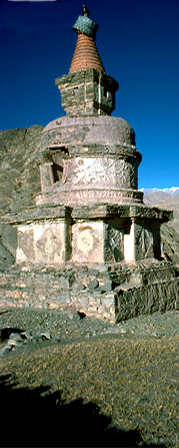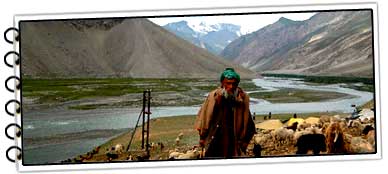
Ladakh Tour - offers tours to Ladakh, LadakhTour Package, Ladakh Cultural Tour, Cycling in Leh & Ladakh.
Ladakh is bounded by world's two mightiest mountain ranges the great Himalayan and the Karakoram, It lies athwart two others The Ladakh and the Zangskar range.
It leaves the first time traveler awestruck by its geographical and cultural difference as they land at Leh. The features of Ladakhi people, their clothes and dialects are similar to Tibetan and Mongoloid then Indian.
It leaves the first time traveler awestruck by its geographical and cultural difference as they land at Leh. The features of Ladakhi people, their clothes and dialects are similar to Tibetan and Mongoloid then Indian.
Ladakh Tour

Home - Ladakh Tourism - Ladakh Glaciers & Rivers
Ladakh Glaciers & Rivers
A mountaineering expedition can turn out to be a lifetime adventure, if it is done on the glaciers that are still craving to be explored. The Himalayan range offers some of the most rigorous mountaineering
 challenges one can ever come across. The glaciers of Ladakh and Kashmir regions can test ones fitness as it will command all the parts of the body to function to the optimum and coordinate to the maximum. There are various glaciers in Ladakh. The major ones are:
challenges one can ever come across. The glaciers of Ladakh and Kashmir regions can test ones fitness as it will command all the parts of the body to function to the optimum and coordinate to the maximum. There are various glaciers in Ladakh. The major ones are: Siachen Glacier
With a vast snowfield in the center, sides strewn with rocks and boulders and a length of about 72-km, Siachen is known as the largest glacier in the world outside the Polar Regions. The Siachen glacier lies in the extreme north-central part of Jammu and Kashmir near the border of India and Tibet and can be approached via Skardu in Ladakh. Located on the north-facing slopes of the Karakoram Range, Siachen feeds the Mutzgah or Shaksgam River that flows parallel to the Karakoram Range before entering into Tibet. Large tributary glaciers like the Shelkar Chorten and Mamostang open into the main glacier from both sides of its trough. Moraines occur at the confluence of larger tributary glaciers and the trunk glacier. The trunk glacier and its tributaries are in the form of a vast ice field, particularly during the winter season when there is continuous snowfall for several weeks at a stretch. Thus the glacier encompasses a vast area in winter and there are virtually no signs of recession.Baltoro Glacier
Wide trough, vast snowfield as central part, sidewalls varying from steep to precipitous are among the various features of this glacier, the glacier which has carved striations on the surrounding country rocks. Moving ice of this glacier has formed depressions, which serve as basins for numerous glacial lakes. Situated on the southern slopes of the central Karakoram Range in the Baltistan area of Jammu and Kashmir, Baltoro can be approached via Skardu in Ladakh. The location of Baltoro is in a huge arena hemmed by high peaks. Shigar River- a tributary of the Indus River, finds its source from this glacier.With a length of about 62-km, it is the second largest glacier in the great Himalayan range. Large tributary glaciers, which feed the main Baltoro glacier include a glacier from the southwestern slopes of the Gasherbrum peak and a tributary glacier from the northwestern slope of the Masherbrum peak, both in the Karakoram.Hispar Glacier
Situated on the southern slopes of the Karakoram Range in the Baltistan area of Ladakh is Hispar Glacier. A very large glacier feeding the main stream of the Shigar River, which in turn drains into the Indus River. The main glacier has a length of about 60-km and is the third largest glacier in the Himalayan region. The glacier is accessible via Skardu in Ladakh. Numerous smaller glaciers join the main glacier on both sides of the amphitheater in which it is located. The central portion of this glacier is a vast snowfield while its sides contain debris eroded by the huge body of moving ice. The entire tract is completely lacking in vegetation of any kind.Nubra Glacier
Spectacularly set on the southern slopes of the Karakoram Range in the Ladakh region of Jammu and Kashmir. It is a large glacier located in a huge amphitheater that is ringed by towering peaks and is approachable via Leh in Ladakh. This glacier gives rise to the Nubra River, which in turn flows, into the Shyok River. Large tributary glaciers open into the main glacier. These include valley glaciers from the northwestern slopes of the Sasser La massif and the southeastern slopes of the Karakoram Range.Small glaciers in hanging valleys feed the Nubra glacier and they occur on all sides of the glacial amphitheater. The central part of this glacier takes the form of a vast snowfield. Lateral moraines are found along the flanks and at the junction of the tributary glaciers and the main glacier. No vegetation grows in this tract as it lies above the snow line.
